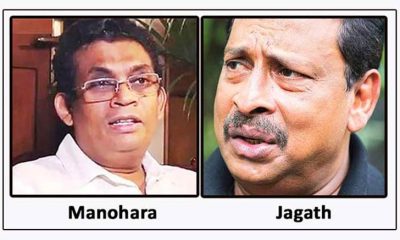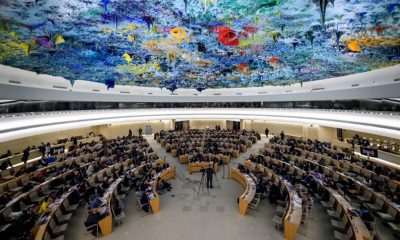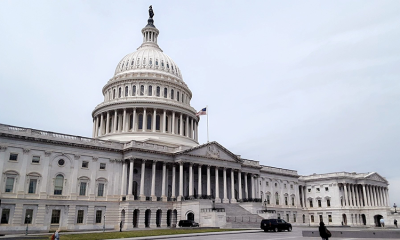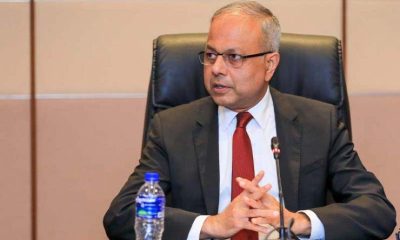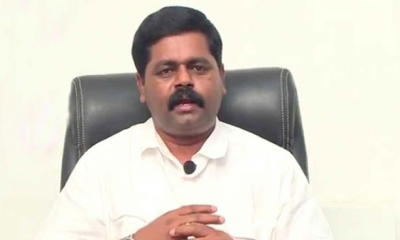Features
Effort to break logjam, Vijaya K, food drop and JR’s letter to Rajiv

(Excerpted from volume ii of the Sarath Amunugama autobiography)
In fact it was Rajiv who made an attempt to break the logjam The Parathasarathy proposals had insisted on the joinder of the North and East. This was a ‘shadow’ of the TULF concept of their ‘traditional homelands’. No Sinhala leader could accept this ‘imaginary nation’ to use the celebrated phrase of Benedict Anderson and hope to survive not only politically but even as a living human being.
‘Kill the old man’ later became a JVP slogan inscribed on city walls. The Sinhalese and Muslims. and even sections of the Eastern Tamils who had been earlier ostracized by the Jaffna Tamils as low caste, were not willing to play second fiddle to the northerners. By now JRJ had accepted the notion of devolution and a second tier of Government by way of Provincial Councils which were originally proposed only for the North and East.
In Bangalore Rajiv shifted the Indian position by suggesting two Provincial Councils – North and East – which as two entities could evolve a system of cooperation at the ground level. Then came the fatal shock for Rajiv. He wanted Prabhakaran who up to then was looked upon as a client of the Indians -whom RAW insisted could be whipped into line – brought to Bangalore to agree to this new formulation which had the consent of the other Tamil groups.
Let us listen to Bernard Tillekeratne, our High Commissioner in Delhi at that time. “It was reported that Prabhakaran, who was then resident in Madras, had initially refused to proceed to Bangalore as desired by Gandhi, to meet Jayewardene and himself, should the need arise during their discussions. However, he was forced to be in attendance in Bangalore but reportedly refused to meet the Sri Lankan President.
At this point Gandhi decided to impose some restrictions on LTTE movement in Tamil Nadu and even sought to prevent Prabhakaran from leaving India, but he slipped across to Jaffna to continue his fight from there.”
This was a historic encounter which had fatal consequences. Some years later both Rajiv and Prabhakaran had premature and violent deaths as a consequence of the Bangalore impasse. Only JRJ died in bed after retirement at a ripe old age.
Intensified Conflict
JRJ flew back to Colombo after establishing cordiality with Rajiv to find that Prabhakaran’s LTTE was adamant in sabotaging a peace deal which had been agreed to by the other Tamil parties. As Bhandari told me, India had invested much hope in a consensus emerging from an all-party conference. JRJ’s invitation had been accepted by the LSSP, CP, NLSSP and Vijaya’s party. Tamil parties, save the LTTE, were also represented.
After the opening session the meeting broke up into different committees to discuss problematic issues. Gamini Dissanayake headed the committee on land matters, and I was asked to assist him. We were able to find unanimity in assigning land alienation undue village expansion to the relevant district as it was the prevailing practice even then. The knotty issue was the development of land under the major schemes in the Eastern Province.
The expansion of the Mahaweli settlement was being held back because of the impasse. We decided that sixty percent of the allotments should be on a ratio of the population in the district and forty percent on national quotas. Regarding the sharing of water on a cross border basis we recommended the setting up of a Riverine Commission, like in India, which would adjudicate on the distribution of water.
This found general acceptance and was indeed used for land alienation subsequently. Similarly other committees too made their recommendations. However the value of these efforts were undermined by the refusal of the party now dominated by Anura, to attend or endorse the findings of the all party conference.
Though the Tamil parties agreed to these suggestions their position on the ground in the North and East was deteriorating rapidly and Prabhakaran, who boasted that he had outwitted the Indians, was launching attacks particularly on unarmed Sinhala and Muslim civilians, which made JRJ’s position extremely unpopular among the Sinhala majority. He was under pressure from Lalith Athulathmudali who had reorganized the army under his watch, to take the fight to the LTTE, which in JRJ’s vulnerable position with the electorate, appeared to be a good move.
Accordingly the Lankan armed forces launched `Operation Liberation’ targeting Vadamaradchi. This was led by Cyril Ranatunga – a smart Sandhurst trained leader, together with Denzil Kobbekaduwa, who was my collegemate, and Wijaya Wimalaratne – three of the ablest fighting generals in our army which up to then had seen many setbacks due to poor leadership.
It was much later in Sarath Fonseka, who was then a subaltern, that we produced a military leader who could take his soldiers to victory. He was ably supported by the then Secretary of Defence, Gotabaya Rajapaksa who too had taken part in the Vadamaratchi operation. Much later in time I was a keynote speaker at the launch of a book by C.A. Chandraprema entitled `Gotas War’. I referred to the combination of persons and events which enabled the Government to successfully conclude the fratricidal war which had changed the trajectory of the country’s future.
Vijayas Call
At about this time I got a call from Vijaya Kumaratunga who played a vital role in the All-Party Conference. It was his bold leadership that helped in the positive outcome of the meeting. By this time he was recognized as the leader of the left and their obvious common candidate at the next Presidential poll. He was adored by his party loyalists as well as film fans who made him the most popular actor on our silver screen.
While many political leaders were ambivalent about devolution and a settlement with the Tamils, it was Vijaya who boldly spoke out on the need for a second tier administration – Provincial Councils – which were closer to the grass roots. Vijaya first told me that Denzil was leading a successful march to the heart of LTTE country in Vadamarachchi. He thought this offensive would change the tide and the All Party Conference conclusions were significant for the next steps in resolving the ethnic crisis.
Of all the leaders it was Vijaya and Chandrika who were winning the confidence of the non LTTE Tamils. Then he dropped a bombshell. He said that JRJ was going to make me the Minister of Information as Anandatissa de Alwis was ill and in hospital. He urged me to accept the offer and on no account have second thoughts. I told him that JRJ had made no such offer and anyway the younger Ministers would be unhappy to see an intruder complicating their well-planned ascent to power.
I heard later that this idea was shot down by them as I expected. But it was true that at that stage I was close to the President, and he would contact me regularly by telephone and also summon me to ‘Braemar’ to discuss the rapidly changing scenario. The only result of this little cameo was that Anandatissa who was very close to me became distant – the wonderful relationship we had could not be recreated due to his jealousy.
After retirement Ananda sent many messages to make up but I felt that I had been badly misunderstood and did not respond with the earlier warmth. One of my characteristics is that once a close friendship is broken it becomes for me to ‘forgive and forget’. On the other hand, this episode highlighted the natural generosity of Vijaya Kumaratunga that could reach out across barriers of politics at a personal level and encourage his friends without petty considerations of advantage
He had good relations with the non LTTE Tamil militants. the LTTE cadres had a regard for him and in typical bold ‘film’ style Vijaya undertook a visit to LTTE held Jaffna to free soldiers who were held hostage by Prabhakaran. His LTTE host was Kangaratnam, an old Trinitian, a fluent Sinhala speaker. Vijaya’s visit was facilitated by Colonel Kotelawela, a strapping six-footer of the army who was the official army liaison in Jaffna with Kanagaratnam who had assumed the ‘nom de guerre’ of Colonel Rahim.
No other Sinhala politician would dare to follow Vijaya’s bold venture. His political enemies circulated a video of Vijaya shooting at a target provided by the LTTE. But he not only returned unscathed but also retained his popularity though earning the hatred of the Sinhala ultras, particularly of the JVP. They marked him as their chief challenge and made plans to eliminate him from the political scene. Vijaya received many warnings from his friends but with typical bravado he chose to ignore them. He even challenged the JVP to harm him.
Nadir of Indo-Lanka Relations
Though JR and Rajiv had established a rapport in Bangalore despite Prabhakaran’s intransigence, the immediate aftermath led to a period when the two countries were on the verge of open conflict. There were four main reasons for the breakdown. The first was the reaction of the LTTE now led on the ground by Prabhakaran, which went on the rampage against unarmed Sinhalese villagers. In Vavuniya they stopped a passenger bus and slaughtered all 140 travelers. The pressure was building on JRJ to act decisively as the Sinhalese looked on him to give a fitting response.
He was conscious of the fact that he was fast losing popularity, which awakened his atavistic fear of losing everything as he did in 1956. The second was the success of ‘Operation Liberation’. The Sri Lankan army was on the verge of defeating the LTTE militarily when the Indian government represented by their ‘gung-ho’. High Commissioner Dixit forced JRJ to call off the offensive much to the anger of the military and Lalith Athulathmudali who gave leadership to the armed services. The Indian Government was giving in to the pressures exerted on it by the Tamil Nadu administration.
The third was the blockade on the North which was enforced on the orders of the President. He had been reading the memoirs of the Secretary of the British Cabinet during the world war, which referred to Churchill’s blockade of Northern Ireland to prevent its support to Hitler. The blockade and its images of starvation that was evoked by the Tamil Nadu administration of M.G. Ramachandran forced the hand of Rajiv whom advisors like Chidambaram believed was being manipulated by the ‘Old Fox’ from Sri Lanka.
Ramachandran unilaterally announced a donation of two million dollars to the LTTE, which brought relations between the two countries to near breaking point. JRj was also afraid of the reaction of the army which had borne the brunt of the fight with the LTTE. Cyril Ranatunga was a loyalist, but he too was under pressure to talk back to the President. As Esmond constantly reminded us, JRJ was afraid of a military coup.
Food Drop
We now come to the lowest Point in Indo-Lanka relations when India decided to unilaterally intervene through a physical violation of a neighboring country’s boundaries. It was an unprecedented violation of Sri Lankan sovereignty and a crossing of the Rubicon which has Permanently affected the relations between the two countries. At the personal level it was a bitter humiliation of a leader whom even his opponents regarded as the best defender of national interests by hook or by crook.
At first the Indians sent a flotilla of ships carrying food supplies. But on JRJ’s personal orders the navy was made ready to intercept them. The Indians then withdrew to base and got ready to airdrop the food supplies in spite of JRJ’s personal entreaty which is reproduced below. Indian Airforce transport planes carrying food cargoes were given an escort of fighter jets. It was touch and go but since we were badly outnumbered the President ordered non retaliation and the food was air dropped unhindered and the planes flew back without a mishap.
It is burnished in the Sinhala psyche as the ‘parippu drop’ on Sri Lankan soil, the first infringement of our airspace after the bombing of Colombo and Trincomalee by the Japanese during the Second World War. This was a sad moment in JRJ’s presidency. The sense of anguish is seen in the draft of a letter to Rajiv that JRJ himself penned and is now in my possession. A photograph of the draft, mostly in JRJs own handwriting, is included in this book. My recollection is that this final version was sent to Rajiv Gandhi. An offer to send Hameed as a personal envoy of the President was turned down by the Indians.
Letter to Rajiv Gandhi
I am reproducing JRJ’s letter to Rajiv Gandhi here not only because it is a historic document but also since it shows the sense of despair and frustration of a man who had always looked to India for inspiration when all his contemporaries either turned to the West or the Soviet Union. There is a legend that when the LSSP leaders in the forties sought to gather him to their fold (As a young lawyer he appeared for Bracegirdle of the LSSP in their challenge to the Colonial Governor’s order of deportation) he responded that he could not join them as he was ‘a follower of the Buddha and a lover of India’. Now he was forced to eat humble pie by a grandson of Nehru whom he had admired throughout his life. He wrote as follows:
“The Cabinet of Ministers has studied very carefully the representations made to his Excellency the President by his Excellency the Prime Minister of India, Shri Rajiv Gandhi. It is apparent that the Prime Minister is both incorrectly informed and wrongly advised.
“Firstly the attempts made over a period of 10 years by the President and his Government to find a political solution to the so called ethnic problem in Sri Lanka are well known to the Government of India, for they too have taken part in discussions since 1983. These steps have been outlined in detail in the President’s addresses to Parliament in 1984,1985 and 1986 and will be summarized again in his address of February 19th with complete documentation. There is nothing more any Sri Lankan Government can offer, now or in the future, without violating the independence, integrity and unity of Sri Lanka’s constitution.
“The Indian Government has stated publicly to the Tamil groups that it does not support the joinder of the northern and eastern provinces, the concept of a Tamil homeland and the creation of a separate state. It is these three issues that supposedly keep these groups from accepting the proposals.
“During these 10 years, except the TULF, the other groups have unleashed a violent, terrorist campaign in which more than 4,000 security personnel, civilians, men, women and children of all races have been killed, many more injured, rendered homeless and suffered immeasurable losses. The latest atrocity has been the killing of several Sinhala women and children, without provocation in the darkness of the night by the cutting of their throats.
As far as we know no terrorist group in the world has been guilty of such inhumane behavior. India has experience of terrorism in several states and particularly in the Punjab where a separatist movement is using violence to achieve its goal.
“The Sri Lanka Government, both politically and militarily has done nothing more nor less than the Indian Government has done and is doing in the Punjab to arrive at a solution. A speech in India made by Prime Minister Gandhi is available. If the proper names are used to indicate Sri Lanka and what is happening here, the speech will apply to Sri Lanka in its entirety.
“And what has the state of Tamil Nadu been doing during these .ten years? It has given refuge to Tamil groups, including those using violence. The leader of the LTTE group Prabhakaran who publicly says he murdered the Tamil Mayor of Jaffna, Mr. Duraiappah, and many others is entertained as a guest by the Chief Minister. He as well as others who direct violence in Sri Lanka, against a lawfully elected democratic government and self-governing local institutions are permitted to buy, possess arms and wireless sets, and train in military exercises. They are permitted to some over to Sri Lanka with men and military material to wage war on an independent, democratic Government.
“Though promises have been made that all this will be stopped these promises have not been fulfilled. Because of open warfare between nine groups a large quantity of arms and equipment was confiscated. The wireless sets that were confiscated were returned.

President JR Jayewardene and Indian Premier Rajiv Gandhi signing the historical Indo-Lanka Accord in 1987. The 13th Amendment to the Constitution facilitated by India through Indo-Lanka Treaty
:They are used to direct the war in Sri Lanka. The Central government of India is aware of these facts. The Government Sri Lanka will not cease its activities to defend democratic institutions and to restore law and order to free its citizens from attacks of a bunch of terrorists, just as much as it will not cease its attempts to arrive at a political solution. While following this two-pronged policy it is entitled to use its powers to persuade its opponents that their efforts cannot succeed but will only cause hardships to inhabitants living in the areas they control, namely the Jaffna Peninsula.
“During the Indian movement for freedom Mahatma Gandhi initiated a boycott of the use of foreign cloth. This hurt the workers in the Lancashire mills in England causing unemployment and severe hardships to hundreds of thousands. During a visit to England in 1931 for the Round Table Conference Mahatma Gandhi visited the Lancashire Mills and saw the hardships caused by his boycott. His reply was ‘Lord Irwin suggested that I give up the boycott for three months as a gesture. I said I could not give it up for three minutes’. [See Gandhi; ‘Essential Writings’, p 309].
“During the 1939 War the United Kingdom enforced a boycott on goods going to and coming from the Ports of Ireland because that Government was sympathetic to the Nazi Government. What we are doing is a legitimate method of non–violent tactics against a deadly foe, and instead of abandoning it, we should intensify it, rather than use more and more violence.
“Summing up we should state that our Government is committed to non-violence. If the terrorist groups give up violence and lay down their arms, the Government will immediately direct the security services to stay in their barracks. We will then implement the Provincial Councils scheme and hold elections so that together with the other seven provinces the people of the northern and eastern provinces may elect their councils, members, Chief Ministers and govern themselves in all the subjects and functions devolved on those councils as discussed and decided with the TULF and the Indian Government. The Tamil groups can take part in these elections for they will be pardoned under an amnesty if they abandon violence.
“All we ask of the Indian Government is, not to permit the soil of India to be used for violent activity against a friendly neighbor and not to permit such activities to be brought to Sri Lanka in the form of men and arms. This Government’s sole aim is to permit democracy and the rule of law flourish once again in the northern and eastern provinces, as in other provinces, under the administration of the elected representatives of the people living in them.
“May the Government of India help us to achieve this goal and may they persuade the Government of Tamil Nadu to do the same for the immortal heritage of India is that “We must not appease evil ….we must remember that evil is not surmounted by using methods that themselves produce more evil….means should not be subordinated to ends”.
“These quotations are from K. Natwar Singh’s book ‘The legacy of Nehru’. All we ask is be true to your heritage, fulfill the legacy of Nehru, refuse to compromise with violence, support the Government of Sri Lanka in its call to terrorists to lay down their arms and discuss your aims and solutions peacefully as we are always prepared to do”.
The Aftermath
The clear violation of Sri Lankan sovereignty came as shock to JRJ and the Government. The anguish is clear in JRJ’s heartfelt letter quoted above. But what was even more disconcerting was the silence of our friends on whom the President had banked heavily to restrain India. While Pakistan made some noises it was counterproductive in that it led to India being more intransigent. But what was disappointing to JRJ was the silence of the western countries which had been wooed assiduously by him.
He was particularly disappointed by the US reaction which relied on backroom warnings to India and not much else. There was no public condemnation by the West, SAARC or the ASEAN. To make the humiliation complete they advocated the hiring of mercenaries to supplement the local armed forces. They were willing to recommend private trainers but were reluctant to `Put boots on the ground’ which would have meant a clash with the Indian armed forces who were strenghtened with Indian weaponry under Rajiv.
Only Fidel Castro, as head of the Non-Aligned Movement, offered to call Rajiv urging caution. It was in this background when the only o[tion seemed to move to serious negotiation which our erstwhile western friends also recommended. With this shift JRJ began to turn to Gamini Dissanayake as his aide, while Lalith, angry that his ‘Operation Liberation’ had been aborted was consigned to the sidelines where he adopted a hawkish approach to India with many tragic consequences as we shall see later.
Features
Sri Lanka to probe ‘corruption’ in handling of 2021 cargo ship disaster
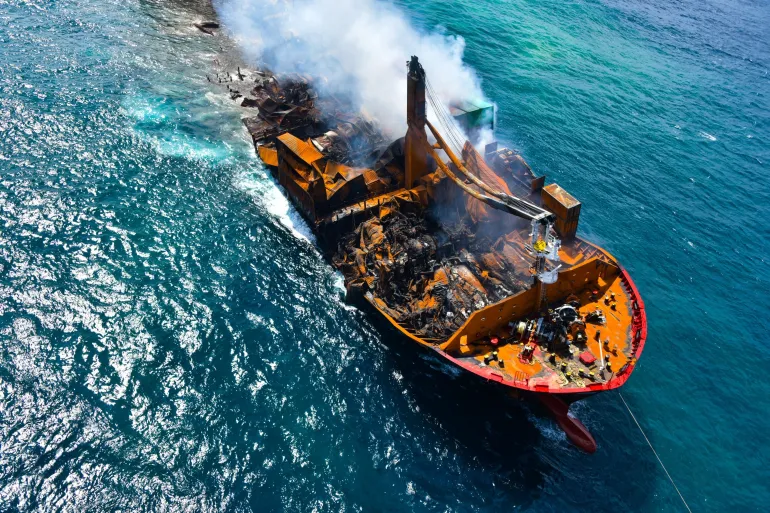
Sri Lanka’s new government, led by left-leaning President Anura Kumara Dissanayake, will launch a fresh investigation into the handling of the MV X-Press Pearl cargo ship disaster that devastated marine life along swaths of the island nation’s coastline three years ago, a senior minister has told Al Jazeera.
The announcement came amid allegations of corruption, delay tactics and mismanagement in dealing with the aftermath of the disaster, and a lack of compensation for the affected fishermen.
In May 2021, the Singapore-registered cargo ship caught fire near Negombo, a popular tourist destination off the Sri Lankan west coast, spilling tonnes of hazardous substances, including nitric acid and microplastic granules, into the Indian Ocean.
The fire on the ship, heading to Sri Lanka’s main city of Colombo from the Indian state of Gujarat, was believed to have been caused by a nitric acid leak. The toxic leak from the ship killed a large number of fish, turtles and other marine mammals, and devastated the livelihoods of more than 20,000 fishing families.

Three years after the fire and oil leak on the ship, people are still awaiting justice in the form of compensation and accountability.
Dissanayake’s government now plans to investigate the incident after the country’s parliamentary elections conclude on November 14. His National People’s Power (NPP) is expected to win the vote.
“There are many allegations about the X-Press Pearl disaster,” Vijitha Herath, the country’s public security minister told Al Jazeera and Watershed Investigations, a United Kingdom-based nonprofit investigative journalism organisation focusing on water issues
“I am personally committed to finding out the truth. We will leave no stone unturned.”
Based on an estimate by a 40-member committee of experts appointed by the country’s Marine Environmental Protection Authority (MEPA) soon after the disaster, Sri Lanka is seeking $6.4bn from London P&I Club, the UK-based insurers of the X-Press Pearl, as compensation for the environmental damage caused by the disaster. The lawsuit was filed in Singapore in April 2023 under the then government, headed by President Ranil Wickremesinghe.
In September this year, a report by the country’s Parliamentary Select Committee (PSC), formed to investigate the handling of the cargo ship disaster and mitigate future risks, said Sri Lanka has so far received nearly $12.5m from London P&I Club.
In addition to that, over the last three years, the MEPA received 3.5m rupees ($11,945), while the Department of Fisheries and Aquatic Resources accepted about 3bn rupees ($10.5m) from London P&I Club – all in local currency, a fact that has raised suspicions of corruption and will now be investigated by the new government.

Darshani Lahandapura, the former head of MEPA, had led the beach cleaning operations following the disaster. She told Al Jazeera that she had come under government pressure to accept the compensation payments in local currency at a time when the country was going through its worst economic crisis as inflation had soared and the Sri Lankan rupee was depreciating.
“Government officials from Wickremesinghe’s administration exerted pressure on me several times to accept the payment in Sri Lankan rupees,” Lahandapura said.
By asking to pay the compensation in local currency, “I believe the shipowners were trying to take an undue advantage of the economic crisis and some government officials were supporting their demand,” she added. The value of the Sri Lankan rupee slumped by almost 50 percent against the US dollar in 2022 when the economic crisis started.
Lahandapura told the PSC she had “strongly resisted” accepting payments in rupees. But the insurers still made two payments in the local currency.
“In her view, accepting payments in rupees might pose a risk of money laundering,” the PSC said in its report, referring to Lahandapura’s statement.
Al Jazeera reached out to the London P&I Club to comment on the allegations, but did not receive any response.
The PSC report concluded that the disaster “exposed critical gaps in the country’s ability to prevent and manage maritime pollution incidents”.
“The Committee found that delays in legal proceedings and inadequate coordination between government agencies had exacerbated the environmental and economic damage,” it said.
Moreover, the lawsuit demanding compensation from the London P&I Club was served by the Sri Lankan authorities 23 months after the disaster occurred, just days before the deadline, stipulated under international law, was set to expire. The law mandates that a claim for compensation in case of a marine accident must be made within two years of the incident. The lawsuit was filed under then-Attorney General Sanjay Rajaratnam.
“There seemed to be some lethargy or intentional delay from the Attorney General’s Department (AGD) in handling the X-Press Pearl vessel disaster case,” Lahandapura, the former head of MEPA, told the parliamentary committee.

However, the then minister of justice, Wijeyadasa Rajapakshe, blamed the MEPA for the delay in filing the lawsuit, saying the marine agency submitted its environmental impact report late.
According to an anonymous official source in the Sri Lankan government, the Attorney General’s Department responded promptly to requests from the shipowners, but took a long time to respond to MEPA’s queries.
“I don’t have evidence to suggest anyone at the AGD received any financial benefit, but if the country’s AGD was lethargic in handling such an important case, it certainly raises suspicion,” the source told Al Jazeera.
Al Jazeera reached out to the Attorney General’s Department for its response to the allegation, but it has not yet received a response. Al Jazeera also sought a response from Rajaratnam, under whom the lawsuit was filed, but he refused to comment.
Another contentious issue likely to be investigated is the decision for the compensation case to be heard in Singapore, where the ship was registered, instead of Sri Lanka, where the accident occurred.
“What we recommended was to litigate the legal case in Sri Lanka,” Dan Malika Gunasekara, a legal expert appointed by MEPA, told Al Jazeera. “However, the Attorney General’s decision to file it in Singapore raises severe questions as to how he arrived at such a decision considering all the surrounding circumstances, especially concerning the consequences.”
Gunasekara was referring to a problem, also highlighted in the PSC report, that due to Singapore being a signatory to the Convention of Limitation of Liability for Maritime Claims (LLMC Convention), the compensation could be limited to approximately 19 million GBP ($24.7m). As the government had estimated the legal costs could reach $10m, it would leave just about $14m for cleanup and compensation.

Critics say the decision to move the lawsuit to Singapore cost the government of Sri Lanka dearly.
“The cabinet of ministers had initially estimated $4.2m as legal costs in Singapore but it was later amended and now $10m has been allocated for the Attorney General’s Department,” said Asela Rekawa, who succeeded Lahandapura as MEPA chairman.
“We were told that we ended up spending precious foreign currency reserves at a time when Sri Lanka was facing bankruptcy because of the foreign currency deficit,” said Professor Ajith de Alwis, co-chair of the MEPA-appointed scientific committee. “In addition, precious little support was available to study the issue in many ways.”
However, according to the PSC report, the London P&I Club had expressed concerns about coming to Sri Lanka “due to the adverse publicity and security fears” and preferred to join the negotiations over the compensation in Singapore.
The then Sri Lankan minister of justice, Wijeyadasa Rajapakshe, also defended the choice of Singapore to litigate the issue.
“Singapore is home to thousands of shipping companies and no company would risk damaging their business by ignoring a ruling from a Singaporean court,” he told Al Jazeera, adding that the decision was made following advice from an Australian legal firm.
“In any case, it might have been difficult to enforce the judgement on a UK company by a Sri Lankan court,” he said.
According to the country’s Fisheries Department, nearly 20,000 fishermen have been paid a total of nearly $10m, but a leader of the fishing trade union said it was not enough.
“The fishermen received different amounts of money as per the area, between 10,000 rupees ($66) and 270,000 rupees ($900) but some had to submit appeals and nearly 2,000 ‘indirect’ fishermen are still hoping to get any compensation,” Roger Peiris, a leader of a fishing trade union, told Al Jazeera, referring to people who sell fish, own boats, or those involved in the dry fish industry.
“But I don’t even count this as compensation, it was just for lack of an immediate income. Compensation for fishermen is something that needs to be discussed separately. Fishermen would only get proper compensation after the legal issues are over.”
(Aljazeera)
Features
Economic stress set to heighten globally as conflicts rage
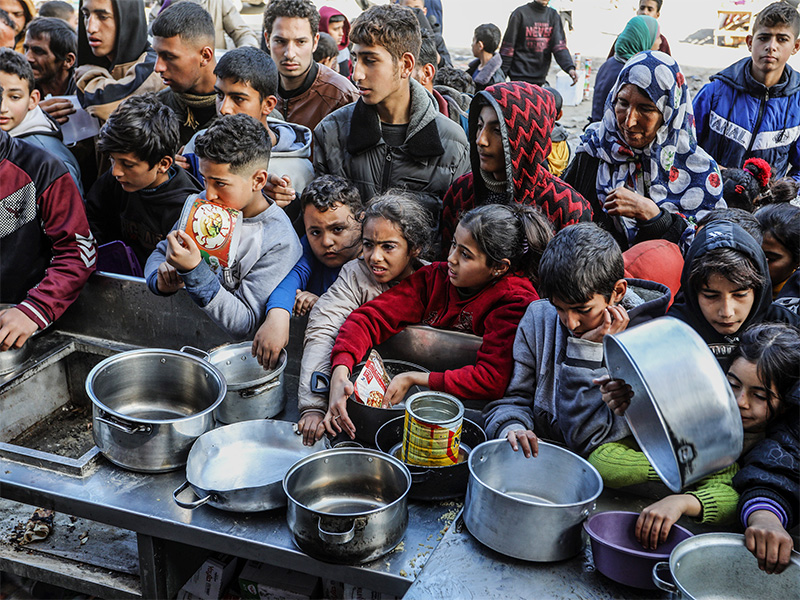
 No less a quarter than the IMF has hinted strongly at possible distressing economic consequences for the world from current conflicts and wars. The IMF’s World Economic Outlook released recently points to an intensification of current ‘geopolitical rifts’ and states that they could negatively impact trade, investments and the free flow of ideas worldwide.
No less a quarter than the IMF has hinted strongly at possible distressing economic consequences for the world from current conflicts and wars. The IMF’s World Economic Outlook released recently points to an intensification of current ‘geopolitical rifts’ and states that they could negatively impact trade, investments and the free flow of ideas worldwide.
The IMF makes the principal observation that overall these tensions could, ‘affect long term growth, threaten the resilience of supply chains and create difficult trade-offs for central banks.’ Small states particularly need to sit up and take notice.
‘The level of uncertainty surrounding the global economic outlook is high’, the IMF warns, among other things, in its wide-ranging report. The challenge emerging from such cautioning for the global South in particular is that it must see the current ‘geopolitical’ conflicts as unprecedentedly undermining its best interests and economic survival.
For sensible opinion anywhere, such warnings are a veritable ‘wake-up call’ to the relevant governments, policymaking bodies and international collaborative organizations to explore urgently the possibility of managing effectively and bringing to an end the current conflicts and wars. Needless to say, the principal theatres of such wars are located in the global South.
The most volatile and unmanageable of such conflicts thus far is the multi-dimensional and multi-frontier war in the Middle East which is already having a globe-wide economic impact. The indications are that the conflict has evolved into a regional war which is seeing the involvement of a multiplicity of regional and international actors, both state and non-state.
It need hardly be said that besides the rising human cost of the conflict, the inability to manage the conflict could have highly disruptive consequences for the world’s oil supplies. Indeed, the global economy is staring an ‘oil shock’ and other distressing results from the conflict squarely in the face.
The Ukraine conflict is no second in severity to the one playing out in the Middle East. In both theatres the world is confronted with wars of attrition that could drastically drain it of its resources and kill its growth prospects.
While the major powers figuring in these conflicts, could, for the present at least, ward off some of their more dire ill consequences, the same does not apply to the South which is home to struggling developing economies. An ‘oil shock’, for instance, could completely disrupt the economies of the latter and render them helpless.
Accordingly, there needs to come into being in the South a collective resolve to manage the relevant conflicts and to help in seeing an end to them, in whichever way possible for the hemisphere. Ideally the South should come together unitedly in this enterprise and ensure that it enjoys independence from ‘outside interference’.
A principal question that arises from these considerations is in which international organization or collective body the global South could come together. For all intents and purposes the Non-aligned Movement and other connected Southern formations are ‘dead’.
This columnist hopes that he would be proved wrong on this score and that the South would awaken to the challenges before it and work vibrantly and unitedly under the Non-aligned banner to meet them. However, thus far we lack the evidence that a truly Non-aligned collectivity could be formed to further the main causes of the South.
It would be irrelevant at this juncture to examine whether Non-alignment in its traditional sense exists or not. It obviously doesn’t. The task before the South is to creatively reinterpret the concept and give it new life by defining it as cordiality with all the states of the world. In the process, ideological blinkers would need to be got rid of. The best interests of the South should be seen as bringing the hemisphere together.
There is a near rush among Southern countries to seek membership of BRICS. On the face of it, there are no problems, so to speak, in such haste, but the issue that needs addressing most is whether the vulnerable of the South could exercise any independence in foreign policy decision making in particular by coming under the BRICS collectivity.
The latter point requires mentioning in view of the fact that BRICS heavyweights, such as China and Russia, are stakeholders in most major wars and conflicts that are ongoing in the world today. The challenge for the weakest countries of the South in this connection is to maintain substantive independence while enjoying the economic empowerment that may come as a result of BRICS membership. Aligning strongly and uncritically with the East is as counterproductive and harmful for the South as veering towards the West in the area of foreign policy.
Accordingly, the South is obliged to revive the more progressive programs of the Non-aligned Movement and connected organizations and seek its economic independence and empowerment free of external, big power interference.
Meanwhile, all is not going to be well on the Western front as well, as international economic disruptions begin to impact the countries of the North. US presidential hopeful Donald Trump shows adequate signs of sizing-up this situation. This accounts for his repeated rhetorical threat, issued in the course of his campaigning, that he would be ensuring the disentanglement of the US from the Ukraine war within ‘24 hours’ of his re-gaining the US presidency.
The US’s military backing for Ukraine is costing the US taxpayer a monumental sum of money and this will eventually lead to a groundswell of popular discontent against the country’s administration. Over the next few remaining days of campaigning, Vice President Kamala Harris would need to give Trump a convincing reply on this thorny question or risk losing the support of more discerning Democrats. After all, economics drives politics.
However, Trump also has a lot of explaining to do to the more scrutinizing sections of the US public. If the US pulls out of the Ukraine tangle at this juncture under a Trump presidency this would amount to ushering a major foreign policy defeat for the US. That is, Russia and its allies would be allowed to pursue their divisive agenda in the Ukraine and eventually maybe ensure the permanent annexation of the Ukraine by Russia. In other words, the principles of national sovereignty and self-determination, two cornerstones of International Law, would be blatantly compromised in the Ukraine.
Thus, the Ukraine is bound to confront any incoming US administration with a compounded crises from which there would not be any easy disentanglement. On the other hand, Russia is, for all intents and purposes, on a suicidal course in the Ukraine because it is hardly making any gains there. Meanwhile, the UN is in a virtual state of paralysis in the face of these crises. The world’s vulnerable are left to their devices as a consequence, unless they act constructively to end their helplessness.
Features
Kind, enthusiastic, energetic and humble…

Chit-Chat Shannon Fernando
 Shannon Fernando, a finalist at the recent Miss Universe Sri Lanka 2024 beauty pageant, impressed many with her infectious smile…and looks. Having completed her bachelor’s degree in business management, she worked, as a banker, at HSBC, for two years, and then moved to SriLankan Airlines where she is now a cabin crew member.
Shannon Fernando, a finalist at the recent Miss Universe Sri Lanka 2024 beauty pageant, impressed many with her infectious smile…and looks. Having completed her bachelor’s degree in business management, she worked, as a banker, at HSBC, for two years, and then moved to SriLankan Airlines where she is now a cabin crew member.
Her advocacy, she says, is raising her voice against child abuse and helping children and adults overcome mental health issues, like depression and anxiety.
1. How would you describe yourself?
Well, I would say I’m a kind, enthusiastic, energetic and a humble person. And, let me add that I’m also a huge animal lover. I love all animals, including birds. I have adopted a dog and a cat and, in fact, I become a mother to the homeless and hungry animals.
2. If you could change one thing about yourself, what would it be?
Let’s say I would learn to have more boundaries in my life.
3. If you could change one thing about your family, what would it be?
More free time for my family so that we can have a vacation together.
4. School?
I studied at Lyceum International and I took part in almost all the extracurricular activities, like athletics, swimming and dancing. I was very shy during my school days but…not anymore!
5. Happiest moment?
I have had many in my life, but the happiest moment was the day of my aviation graduation where I became an official cabin crew member for SriLankan Airlines. It was my childhood dream.
6. What is your idea of perfect happiness?
My idea of perfect happiness is celebrating Christmas one day, with a family of my own…a caring husband, and beautiful kids. At the end of the day, all you need is love and affection, and a loving home to come to after a long day at work.
7. Are you religious?
I am religious. I’m a Roman Catholic. I believe in Jesus and he’s my first love. And the reason I’m what I’m today is because of Jesus. But I believe and respect every other religion because every religion teaches us to be kind and walk in love.
8. Are you superstitious?
No, I’m not. However, I believe in manifestation. I believe in the law of attraction and universe is aligned with us.
9. Your ideal guy?
My ideal guy would be handsome, caring, kind, understanding and patient, who will take care of me till the end.
10. Which living person do you most admire?
The living person I admire the most is my mother. She’s the one who believes and never gives up on me. She always has my back.
11. Which is your most treasured possession?
My treasured possession is my kind heart. No matter how cruel people had been to me, I have never changed myself. Kindness can heal anyone.
12. If you were marooned on a desert island, who would you like as your companion?
If I was marooned in a desert island I would like to have my sister, Kiara, as my companion…and she is my only sister.
13. Your most embarrassing moment?
I don’t have any embarrassing moments. However, I used to be a very shy and timid girl back in the days, but now I’m so confident…with all the challenges and experience I have faced in life.
14. Done anything daring?
I gave this question much thought but nothing came to mind!
15. Your ideal vacation?
My ideal vacation is a trip upcountry, spend at least three to four days with my best friends and have a good time.
16. What kind of music are you into?
I listen to all pop songs, and my favourite artiste is Taylor swift.
17. Favourite radio station:
Sun FM as I enjoy the music they dish out to listeners.
18. Favourite TV station:
I don’t have much free time to watch TV. However, my all day favourite TV series is ‘Friends’. I have watched all 10 seasons a million times and I still don’t get fed up watching ‘Friends’. I would say it’s the most hilarious TV show ever.
19 What would you like to be born as in your next life?
I don’t believe in after life because I’m a Catholic.
20. Any major plans for the future?
Nothing major but I want to do well in my career as cabin crew; do part time modelling, and take part in TV commercials and movies. I will also participate in upcoming pageants because I don’t want to give up on my dreams. And I want to build a community to help children who are going through child abuse and children and adults who are having mental health difficulties.
-
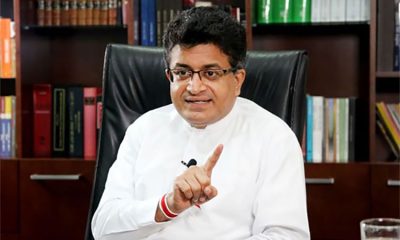
 News7 days ago
News7 days agoGammanpila challenges Minister Herath over allegations against former judge
-
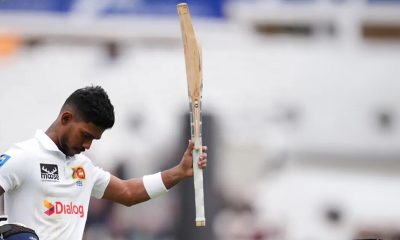
 Sports5 days ago
Sports5 days agoPassing the torch; Sri Lanka’s next batting dynamos
-

 Sports7 days ago
Sports7 days agoSri Lanka riding high on an impressive run
-

 Editorial7 days ago
Editorial7 days agoAcid test of leadership
-
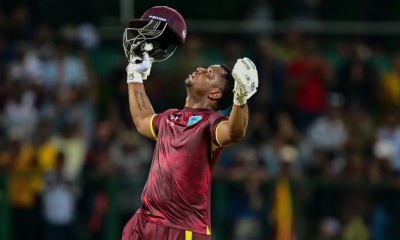
 Latest News5 days ago
Latest News5 days agoLewis’ 61-ball century trumps Kusal’s 19-ball fifty in 23-over shootout
-
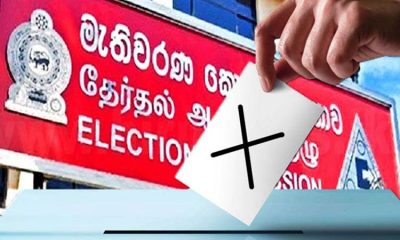
 News7 days ago
News7 days agoEC displays expense reports of 37 presidential candidates
-
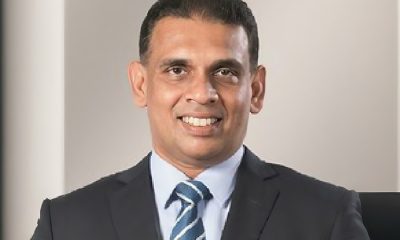
 News4 days ago
News4 days agoNo immediate drop in tourist arrivals – tour operators
-

 News7 days ago
News7 days agoSituation under control: Travel advisories will be withdrawn soon: Govt.


